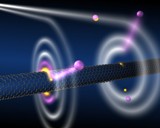Publication by graduate students Anne Goodsell and Trygve Ristroph with Professors Lene Hau and Jene Golovchenko in the April 2, 2010 issue of Physical Review Letters was selected as the cover story, as an Editor's Suggestion, featured in a Synopsis in Physics: the APS publication "spotlighting exceptional research", and picked as a Nature Research Highlight. Cold-atom and nanoscale science have each provided exciting new systems for study and applications. We report the first experimental realization of a combined cold atom-nanostructure system that represents a new paradigm at the interface of these two disciplines. Atoms are laser cooled to microkelvin temperatures and then launched towards a single, freely suspended carbon nanotube charged to hundreds of volts. The nanotube acts as a 'black hole': Atoms are attracted to the nanotube from distances more than a hundred times the tube diameter, and spiral towards the tube under dramatic acceleration with orbit times reaching just a few picoseconds. Close to the nanotube, an atom's valence electron tunnels into the tube, converting the atom into an ion that is ejected at high energy and easily detected. The system demonstrates sensitive probing of atom, electron, and ion dynamics at the nanoscale, and opens the door to a new generation of cold atom experiments and nanoscale devices. "Field Ionization of Cold Atoms near the Wall of a Single Carbon Nanotube." Phys. Rev. Lett. 104, 133002 (2010).
Click here for Supplementary Information on the article.
 image credit: Anne Goodsell & Tommi Hakala Click here for high resolution image. |
Read press...
Harvard press release:
COLD ATOMS AND NANOTUBES COME TOGETHER IN AN ATOMIC 'BLACK HOLE'
Atoms spiral towards a charged carbon nanotube under dramatic acceleration before splitting apart
CAMBRIDGE, Mass., April 6, 2010 -- Carbon nanotubes, long touted for applications in materials and electronics, may also be the stuff of atomic-scale black holes.
Physicists at Harvard University have found that a high-voltage nanotube can cause cold atoms to spiral inward under dramatic acceleration before disintegrating violently. Their experiments, the first to demonstrate something akin to a black hole at atomic scale, are described in the current issue of the journal Physical Review Letters.
"On a scale of nanometers, we create an inexorable and destructive pull similar to what black holes exert on matter at cosmic scales," says Lene Vestergaard Hau, Mallinckrodt Professor of Physics and of Applied Physics at Harvard. "As importantly for scientists, this is the first merging of cold-atom and nanoscale science, and it opens the door to a new generation of cold atom experiments and nanoscale devices."
Hau and co-authors Anne Goodsell, Trygve Ristroph, and Jene A. Golovchenko laser-cooled clouds of one million rubidium atoms to just a fraction of a degree above absolute zero. The physicists then launched this millimeter-long atomic cloud towards a suspended carbon nanotube, located some two centimeters away and charged to hundreds of volts.
The vast majority of the atoms passed right by the wire, but those that came within a micron of it -- roughly 10 atoms in every million-atom cloud -- were inescapably attracted, reaching high speeds as they spiraled toward the nanotube.
"From a start at about 5 meters per second, the cold atoms reach speeds of roughly 1,200 meters per second, or more than 2,700 miles per hour, as they circle the nanotube," says Goodsell, a graduate student on the project and now a postdoctoral researcher in physics at Harvard. "As part of this tremendous acceleration, the temperature corresponding to the atoms' kinetic energy increases from 0.1 degrees Kelvin to thousands of degrees Kelvin in less than a microsecond."
At this point, the speeding atoms separate into an electron and an ion rotating in parallel around the nanowire, completing each orbit in just a few trillionths of a second. The electron eventually gets sucked into the nanotube via quantum tunneling, causing its companion ion to shoot away -- repelled by the strong charge of the 300-volt nanotube -- at a speed of roughly 26 kilometers per second, or 59,000 miles per hour.
The entire experiment was conducted with great precision, allowing the scientists unprecedented access to both cold-atom and nanoscale processes.
"Cold-atom and nanoscale science have each provided exciting new systems for study and applications," says Golovchenko, Rumford Professor of Physics and Gordon McKay Professor of Applied Physics at Harvard. "This is the first experimental realization of a combined cold atom-nanostructure system. Our system demonstrates sensitive probing of atom, electron, and ion dynamics at the nanoscale."
The single-walled carbon nanotube used in these researchers' successful experiment was dubbed "Lucy," and its contributions are acknowledged in the Physical Review Letters paper. The nanotube was grown by chemical vapor deposition across a 10-micron gap in a silicon chip that provides the nanowire with both mechanical support and electrical contact.
"From the atom's point of view, the nanotube is infinitely long and thin, creating a singular effect on the atom," Hau says.
This work was supported by the Air Force Office of Scientific Research and the National Science Foundation.